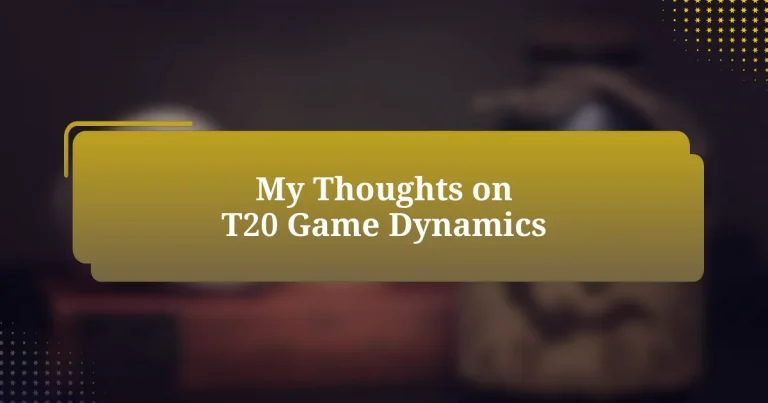Key takeaways:
- The contrasting nature of cricket formats shapes both player strategies and fan experiences, with Test matches emphasizing patience and T20 offering fast-paced excitement.
- T20 cricket has revolutionized player careers, leading to a greater focus on explosive skills and adaptability, making the sport more engaging for new fans.
- Key strategies for T20 success include flexibility in team tactics, aggressive starts in the powerplay, and effective death bowling, which can drastically alter match outcomes.
- Individual brilliance and astute captaincy play significant roles in T20 dynamics, with moments of outstanding performance creating memorable shifts in game momentum.
Author: Evelyn Hartwell
Bio: Evelyn Hartwell is a contemporary fiction author known for her poignant storytelling and richly drawn characters. With a background in psychology, she explores the intricacies of human emotions and relationships in her novels. Her work has been featured in several literary magazines and anthologies, earning accolades for its depth and insight. When she’s not writing, Evelyn enjoys hiking in the mountains and nurturing her passion for photography. She lives in Asheville, North Carolina, with her two rescue dogs and a stack of well-loved books.
Understanding cricket formats
Cricket, with its various formats, offers a rich tapestry of gameplay that fascinates fans worldwide. I recall going to a local ground with friends, where we experimented with the different formats ourselves. The dynamic energy of T20 contrasted sharply with the strategic depth of Test matches; it’s like experiencing two different sports in one.
As I delve into the formats, I often wonder how each has shaped not only the players but also the fans’ experience. In longer formats like Tests, every ball bowled tells a story, building tension over five days. On the other hand, T20 seems to captivate audiences with its whirlwind pace, making cricket accessible and thrilling. Have you ever thought about how these formats cater to different emotions? It’s fascinating how a single sport can evoke such varied feelings.
In my opinion, understanding these nuances is crucial for any cricket lover. Each format demands unique skills and strategies, whether it’s the patience needed in an ODI or the explosive tactics required in T20. These differences deepen our appreciation for the game as a whole, and I’ve found that discussing these elements with fellow enthusiasts often leads to passionate debates that enhance our love for cricket.
Overview of T20 cricket
T20 cricket revolutionizes the game with its electrifying pace and entertainment value. Just the other day, I was watching a T20 match with friends, and the excitement was palpable as boundaries flew, and wickets tumbled in rapid succession. It’s remarkable how this format compresses the intense drama of cricket into just three hours, allowing for a thrilling experience that keeps fans on the edge of their seats.
One aspect that often strikes me is how T20 has changed the landscape of player careers. Players now focus on explosive hitting and agile fielding, skills that are less emphasized in longer formats. Reflecting on previous matches, I’ve seen players reinvent themselves and rise to stardom; it almost feels like watching a thrilling action movie unfold with each ball.
What really excites me about T20 is the sense of unpredictability it brings to the game. Have you experienced that rush when a typically weaker team pulls off a stunning upset? I once witnessed a local T20 match where an underdog team chased down an imposing score against all odds. The sheer electricity in the crowd was unforgettable, reminding me that, in T20 cricket, anything is possible.
Key features of T20 game
The rapid gameplay is one of the most striking features of T20 cricket. Each bowler has to be strategic, knowing they only have a limited number of deliveries to make an impact. I still remember a T20 match where a bowler unleashed a surprise delivery in his final over, turning the tide and clinching victory for his team. It’s moments like these that highlight the importance of decision-making in a compressed timeline.
Another defining characteristic is the emphasis on power hitting. I often find myself in awe of players who can send the ball soaring over boundaries with such ease. In one tournament, I saw a batsman take on a bowler known for his pace, smashing sixes that left both the crowd and the opposition in disbelief. It’s a reminder that T20 is as much about precision as it is about brute strength.
Finally, team dynamics play a crucial role in T20 cricket. With fast-paced matches, communication and coordination become essential. I distinctively recall a nail-biting finish where the synergy between the wicketkeeper and the bowler led to a game-changing run-out. It’s that blend of individual brilliance and teamwork that captivates fans and keeps them coming back for more. Have you ever wondered how tightly knit teams can turn the tide with a single brilliant play? That’s the magic of T20.
Impact of T20 on cricket
The impact of T20 on cricket is profound. It has introduced a new energy that resonates beyond the game itself. I recall my first live T20 match, where the atmosphere felt electric; every run, every wicket had the crowd on its feet. This kind of excitement wasn’t as pronounced in longer formats, showcasing how T20 has the power to draw new fans to the sport.
Moreover, T20 has reshaped player career trajectories. Players now focus more on versatile skills, blending batting, bowling, and fielding to thrive in this format. I remember speaking to a budding cricketer who emphasized his training on power hitting and tactical bowling in a way that felt tailored for T20 leagues. Isn’t it fascinating how this shift has led cricketers to diversify their skill sets, adapting to evolving demands?
T20 cricket has also influenced global cricketing culture. The simpler scoring formats and shorter matches have made the game more accessible to a wider audience. I often find myself discussing recent matches with friends who previously knew little about cricket. This format has truly broadened the sport’s appeal. How many times have you seen someone who never followed cricket suddenly get hooked on a thrilling T20 contest? It’s incredible how just a few hours can convert a casual observer into an engaged fan.
My favorite T20 teams
When it comes to my favorite T20 teams, I can’t help but cheer for the Chennai Super Kings. Their consistent performance and leadership from someone like MS Dhoni create an aura of confidence that’s hard to rival. Watching them clinch victory in nail-biting finishes brings back memories of countless late nights glued to my screen, heart racing with anticipation.
I also have a soft spot for the Kolkata Knight Riders. Their blend of young talent and seasoned players reminds me of the importance of teamwork in T20 cricket. I distinctly recall a match where Andre Russell took the game away from the opponents single-handedly, and I couldn’t help but think, isn’t it inspiring to see one player change the course of the game with sheer determination?
Then there’s the Royal Challengers Bangalore, a team laden with star power. Although they haven’t grabbed the title yet, their high-octane matches provide some of the most thrilling encounters. The infectious energy of their fan base during those close contests always makes me think—what makes a team truly great? Is it the trophies or the exhilarating moments that capture our hearts? For me, it’s definitely the latter.
Strategies for T20 success
When it comes to crafting strategies for T20 success, the key lies in adaptability. I remember a match where a team switched their batting order mid-game, catching the opposition off-guard and altering the match’s momentum. This change illustrates that being flexible and quick in decision-making can turn the tables in a high-pressure environment like T20 cricket.
Another crucial strategy is understanding the importance of pace in the innings. I’ve seen teams explode in the powerplay, setting a dominant tone for the rest of the match. This aggressive start often takes the wind out of the opposition’s sails—especially when players like Chris Gayle blast boundaries right from the start. Spoiling the opponent’s plans early can be a game-changer.
Lastly, effective death bowling cannot be overlooked. I fondly recall a tense last over where a bowler executed yorkers with such precision, it sent shivers down my spine. It’s moments like those that underscore how critical it is to develop a skillset that includes varied bowling techniques to defend small totals or chase down scores. How can you secure your victory if you can’t handle the pressure in those final overs?
Personal insights on T20 dynamics
In my experience, the unpredictability of T20 cricket is one of its most riveting dynamics. Just last season, I watched a match where a team down by 90 runs found themselves taking the game to the wire. It’s fascinating how one outstanding performance can change the entire atmosphere, leaving both players and spectators on the edge of their seats. How is it that such momentum shifts can occur so rapidly? It’s that suspense that hooks me every time.
Another aspect that stands out to me is the role of individual brilliance in T20. I often think back to a player who, seemingly single-handedly, turned the tide in a critical playoff game. With each six hit, the crowd erupted in cheers, feeding into his confidence and heightening the tension for the opposing side. It’s those moments where sheer talent blends with the electric atmosphere that makes T20 feel so alive.
Moreover, the tactics employed in field placements can be a game-changer. I vividly remember a nail-biting finish where a captain’s astute field decisions squeezed the runs and applied psychological pressure on the opposing batsmen. Watching that unfold, I found myself asking, what makes a captain truly great in T20? It’s that blend of intuition, experience, and a deep understanding of the game that can elevate a team’s performance significantly.


